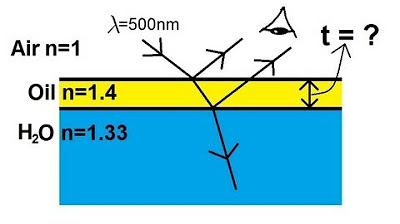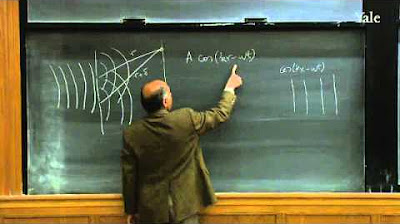Physics 60 Interference of Light (7 of 8) The Thin Film
TLDRThis educational video explores the concept of destructive interference in thin film optics to minimize light reflection from optical lenses. By applying a coating with a thickness calculated as \( \frac{\lambda}{4n} \), where \( \lambda \) is the wavelength of light and \( n \) is the refractive index of the coating, all light at a specific wavelength, such as the red-orange range, can be transmitted without reflection. This technique is crucial for telescopes and binoculars to maximize light collection in night vision, ensuring clarity and minimizing glare.
Takeaways
- 🌟 The video discusses achieving destructive interference on an optical lens coating to minimize light reflection.
- 🔍 To create this effect, the phase difference between reflected light waves should be half a wavelength (λ/2).
- 📏 The extra distance traveled by the light wave in the coating is crucial and should equal λ/2N, considering the refractive index (N).
- 🌌 Phase shifts at the boundaries of the coating material are considered, but if they are equal, they can be ignored for the calculation.
- 🛠 The extra distance traveled is also twice the thickness of the coating, leading to the equation 2t = λ/2N, where t is the thickness of the coating.
- 🎨 The video suggests using this technique in optical devices like telescopes to maximize light transmission and minimize reflection for better viewing at night.
- 🔴 The example given uses a wavelength of 600 nm, corresponding to the reddish color spectrum, to demonstrate the calculation.
- 📉 By setting the coating thickness to 107 nm with a refractive index of 1.4, light at 600 nm would be efficiently transmitted without reflection.
- 🌠 This coating is particularly useful for astronomical observations to ensure that as much light as possible is collected from celestial objects.
- 👓 The process is relevant for creating anti-reflective coatings for lenses in devices like telescopes and binoculars used for night vision.
- 🛡️ The final goal is to have an optical coating that allows for the transmission of light without any significant reflection, enhancing the viewing experience.
Q & A
What is the main objective of the video discussed in the transcript?
-The main objective of the video is to explain how to achieve destructive interference on reflected light to prevent any light reflection from an optical lens, particularly useful in applications like telescopes where maximum light transmission is desired.
What is destructive interference and why is it important in this context?
-Destructive interference occurs when two waves of the same frequency meet and combine in such a way that they cancel each other out. In this context, it is important to ensure that no light is reflected back from the lens, allowing for maximum light transmission.
What is the phase difference required for destructive interference to occur?
-The phase difference required for destructive interference to occur is half a wavelength (λ/2), as this ensures that the waves interfere with each other and cancel out.
How does the index of refraction affect the calculation of the extra distance traveled by light?
-The index of refraction affects the calculation by altering the speed of light in the medium. The extra distance traveled is given by λ/(2N), where N is the index of refraction of the medium.
What is the significance of the phase shifts at the boundaries in the context of the video?
-Phase shifts at the boundaries occur when light transitions from one medium to another with a different index of refraction. These phase shifts are important because they can affect the overall phase difference required for destructive interference.
Why can we ignore the phase shifts at the boundaries if they are the same on both?
-If the phase shifts are the same at both boundaries, they do not contribute to the overall phase difference between the reflected and transmitted waves, and thus can be ignored in the calculation for destructive interference.
What is the relationship between the thickness of the coating and the extra distance traveled by light?
-The extra distance traveled by light is equal to twice the thickness of the coating (2t). This is important for setting up the condition for destructive interference.
What type of optics would benefit from this kind of anti-reflective coating?
-Optics such as telescopes that are used for observing the night sky would benefit from this kind of anti-reflective coating, as it allows for maximum light transmission and minimizes light loss due to reflection.
What wavelength of light is primarily considered in the example given in the transcript?
-The example in the transcript primarily considers the wavelength of light in the reddish color range, specifically around 600 nanometers (600 nm).
How is the thickness of the coating calculated to achieve the desired destructive interference?
-The thickness of the coating (t) is calculated using the formula t = λ/(4N), where λ is the wavelength of light and N is the index of refraction of the coating material.
What is the calculated thickness of the coating if the wavelength is 600 nm and the index of refraction is 1.4?
-The calculated thickness of the coating would be 107 nanometers (107 nm), using the formula t = 600 nm / (4 * 1.4).
Outlines
🌌 Achieving Zero Reflection in Optical Lenses
The script discusses the concept of using a thin film coating on optical lenses to achieve destructive interference, thereby eliminating light reflection. The goal is to ensure that all light is transmitted through the lens, which is particularly important for telescopes observing the night sky. The process involves adjusting the thickness of the coating to create a phase difference of half a wavelength between reflected waves, resulting in their cancellation. The script explains the need to consider the refractive index of the coating material and any phase shifts at the boundaries. The optimal thickness of the coating is calculated based on the wavelength of light, specifically targeting the red part of the spectrum at 600 nm, to ensure maximum transmission and minimal reflection.
Mindmap
Keywords
💡Light
💡Interference
💡Thin Film
💡Destructive Interference
💡Phase Difference
💡Wavelength
💡Refractive Index
💡Coating
💡Optical Lens
💡Phase Shift
💡Telescopes
Highlights
The goal is to create a coating on an optical lens that causes no light reflection, using destructive interference.
Destructive interference occurs when there is a half-wavelength phase difference between two light waves.
The extra distance traveled by the second wave must be equal to half the wavelength (λ/2) to achieve destructive interference.
The index of refraction affects the path difference, so λ/2N is used instead of just λ/2.
Phase shifts at the boundaries between different media are considered in the calculation.
If phase shifts are the same at both boundaries, they can be ignored for the interference calculation.
The extra distance traveled is twice the thickness of the coating (2t).
The condition for destructive interference is 2t = λ/2N.
This coating is useful in optics like telescopes to maximize light transmission and minimize reflection.
The coating thickness can be calculated for a specific wavelength to optimize transmission.
For telescopes observing the night sky, a wavelength around 600 nm (red light) is considered.
The coating thickness t is calculated as λ/4N for the desired wavelength.
For a coating with an index of refraction of 1.4, the calculated thickness is 107 nm for 600 nm wavelength light.
Applying a 107 nm coating with index 1.4 will transmit light in the 600 nm range without reflection.
This technique is optimal for telescopes and binoculars used for night vision.
The process demonstrates how to design an anti-reflective coating for specific wavelengths.
Transcripts
Browse More Related Video

Physics 60 Interference of Light (6 of 8) The Thin Film: Oil

Physics 60 Interference of Light (5 of 8) The Thin Film

18. Wave Theory of Light

Physics 60 Interference of Light (8 of 8) Glass Plates

How Optics Work - the basics of cameras, lenses and telescopes

Total Internal Reflection and Critical Angle - A Level Physics
5.0 / 5 (0 votes)
Thanks for rating: